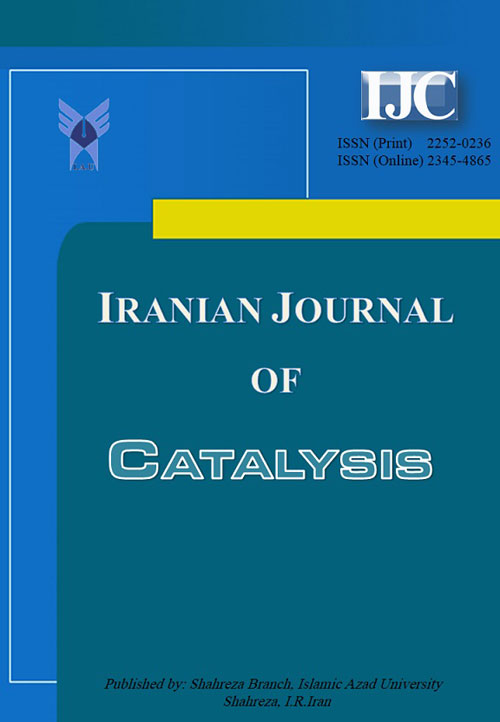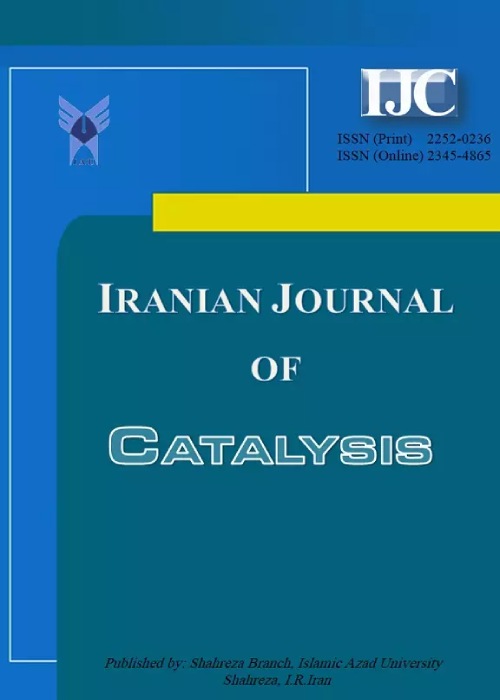فهرست مطالب

Iranian Journal of Catalysis
Volume:5 Issue: 4, Autumn 2015
- تاریخ انتشار: 1394/04/06
- تعداد عناوین: 13
-
-
Pages 297-303A simple, mild and high efficient procedure for one pot three component synthesis of 2-amino 4-H chromene derivatives was studied. The reaction was performed in water using aryl aldehydes, malononitrile and resorcinol, phloroglucinol or naphthole in the presence of N-methyl D-glucamine (Meglumine) as a green high efficient catalyst. The reaction was studied in thermal, microwave (MW) and ultrasonic (US) conditions. Obtained results show that meglumine, as a green catalyst, has high efficiency in all reaction conditions and the yield of products (in all cases) is high to excellent. Environment friendly solvent and catalyst, short reaction times and high yield products are the advantageous of presented research.Keywords: Chromenes, Meglumine, One, pot, Green Conditions, Ultrasonic, Microwave
-
Pages 305-309Ni2+ supported on hydroxyapatite-core@shell γ-Fe2O3 nanoparticles (γ-Fe2O3@HAp-Ni2+) was found to be a useful catalyst for the synthesis of benzimidazole derivatives from o-phenylenediamine and aldehydes under solvent and solvent-free conditions at 80 °C. This reaction affords the corresponding benzimidazole derivatives compared with the classical reactions this method consistently gives a high yield, easy magnetic separation, a short reaction time, simple workup and recyclable property of the catalyst. In this way, the catalyst was readily recovered using an external magnet and could be reused in five consecutive runs without significant loss of reactivity. The mean size and the surface morphology of the nanocatalyst were characterized by TEM, SEM, VSM, XRD and FTIR techniques.Keywords: Benzimidazole, Ni2+ supported, γ, Fe2O3 nanoparticlesoPhenylenediamine
-
Pages 311-320Nanomagnetite-Fe3O4 is used as a highly efficient, mild, green and recyclable nanomagnetite catalyst for the synthesis of 4,4´-(arylmethylene)-bis(3-methyl-1-phenyl-1H-pyrazol-5-ol) derivatives in solvent-free conditions. The condensation reaction of 3-methyl-1-phenyl-1H-pyrazol-5(4H)-one with aromatic aldehydes affords the title compounds in high yields and short reaction times. The nanocatalyst is reusable for seven times without significant loss of its catalytic activity. Short reaction times, high yields, generality, efficiency, recyclability of the catalyst for seven times, simple purification, clean reaction, and agreement with the green chemistry protocols are some advantages of in this method. the catalyst was characterized by transmission electron microscopy (TEM), Fourier transform infrared spectroscopy (FT-IR), X-ray diffractometer (XRD) and vibrating sample magnetometer (VSM).Keywords: Nanomagnetite, Fe3O4, Nanomagnetite, 4, 4´, (Arylmethylene), bis(3, methyl, 1, phenyl, 1H, pyrazol, 5, ol), 3, Methyl, 1, phenyl, 1H, pyrazol, 5(4H), one, Aromatic aldehyde
-
Pages 321-326ZrP2O7 nanoparticles have been used as an efficient catalyst for the preparation of 2-aryl-5-methyl-2,3-dihydro-1H-3-pyrazolones by a simple one-pot four-component reaction of phenyl hydrazines, ethyl acetoacetate, β-naphthol and benzaldehydes under microwave irradiation in good to excellent yields. When the reaction was carried out using ZrOCl2.8H2O, ZrO2 and ZrP2O7 NPs as the catalyst, the product were obtained in moderate to good yield. The highest yield 92% was reached when the reaction was performed with 0.6 mol% of catalyst loading. Atom economy, green reaction, short reaction times, easy isolation of the targeted molecules, recovery and reusability of the catalyst are some of the important features of this protocol.Keywords: ZrP2O7 nanoparticles, Pyrazolones, Microwave, Reusable catalyst
-
Pages 327-331o-Xylylenebis (triphenylphosphonium peroxymonosulfate) (1) was easily prepared from an aqueous solution of oxone and o-xylylenebis- (triphenylphosphonium bromide). This Compound (1) is a useful and selective reagent for conversion of oximes, semicarbazones and phenylhydrazones to the corresponding carbonyl compounds. The reaction was carried out under solvent-free conditions and in the presence of catalytic amount of aluminium chloride. This method shows a good selectivity in oxidation of oximes, semicarbazones and phenylhydrazones in the presence of aliphatic and aromatic alcohols. The advantages of the present method include good functional group tolerance, high yields of products, simple experimental procedure and purification, no solvent and short reaction times.Keywords: Oxidation, Oxime, Semicarbazone, Phenylhydrazone, Solvent, free
-
Pages 333-337The Nano-CrY zeolite synthesized and characterized by Fourier transfer infrared (FT-IR), X-ray diffraction (XRD),and Scanning electron microscopy (SEM).The result show that nano catalyst prepared with mainly particles size about 30-80 nm. The XRD show the structure of the zeolite does not collapse. This Nano-CrY zeolite has been used as new, and nontoxic catalyst for catalyzes of synthesis of 2-aryl-1H-benzothiazoles at mild condition. This procedure is simple, effective, inexpensive and green. The products were obtained in high yields and the catalyst is reusable. Since products were obtained by aqua work-up in good purity and complex purification methods are not necessary.Keywords: Nano, CrY zeolite, 2, Aryl, 1H, benzothiazoles, Nanocatalyst, 2, Aminothiophenol, Cyclocondensation
-
Pages 339-343For the first time lactic acid was applied as an efficient and green catalyst for the one-pot three-component synthesis of amidoalkyl naphthols via the condensation between arylaldehydes, 2-naphthol and amides or urea under thermal solvent-free conditions in good to excellent yields. We have demonestrated a mild and efficient eco-friendly tandem synthesis of amidoalkyl naphthols using lactic acid as a novel organoacid green promoter, which uses neither harsh conditions nor the use of hazardous or toxicant catalysts and reagents. This methodology has a number of advantages including: short reaction times, high yield, use of non-toxic and inexpensive catalyst, elimination of solvent and easy work-up.Keywords: Lactic acid, Amidoalkyl naphthol, Solvent, free, Thermal condition
-
Pages 345-350Functionalized indeno[1,2-b]chromene derivatives have been synthesized via condensation reaction of 1H-indene-1,3(2H)-dione with benzaldehyde and cyclization with 2-hydroxynaphthalene-1,4-dione in the presence of a catalytic amount of triethylamine (Et3N) in EtOH at room temperature. It was observed that benzaldehyde bearing electron donating group gave high yield of product, whereas, benzaldehyde having electronic withdrawing substituent does not participate in this reaction. The structures were confirmed spectroscopically (IR, 1H- and 13C-NMR, and Mass). A plausible mechanism for this reaction is proposed (Scheme 2). Good yields and easy purification are the main advantages of the present method. Products of these reactions have structural similarity to naturally occurring pyranokunthone B, lambertellin, β-lapachone, and α-xiloidone.Keywords: Indeno[1, 2, b]chromene, Condensation reaction, 1H, Indene, 1, 3(2H), dione, 2, Hydroxynaphthalene, 1, 4, dione
-
Pages 351-355In this work, we attempted to synthesize thallium (III) oxide nano structures by direct thermal decomposition using thallium I phenylsuccinic acid coordination polymer [Tl(PsucH)]n as a precursor. Also, Tl2O3 nanoparticles have been characterized by scanning electron microscopy (SEM), X-Ray powder diffraction (XRD) and IR spectroscopy and then we report a simple and efficient method for the synthesis of α,α''-benzylidene bis(4-hydroxycoumarin) derivatives by aromatic aldehyde and 4-hydroxycoumarin by using Tl2O3 nanoparticles in H2O/EtOH at room temperature. A wide spectrum of functional groups, were tolerated in the developed protocol. The target molecules were obtained in good to excellent yield applying the current method. The catalyst can be recover for the subsequent reactions and reused without loss of activity.Keywords: Thallium (III) oxide nanostructures, 4, Hydroxycoumarin, α, α', Benzylidene bis(4, hydroxycoumarin), Aromatic aldehyde
-
Pages 357-364Multiwalled carbon nanotubes (MWCNTs) have been functionalized with -SO3H groups using new three steps chemical routes. Firstly, OH groups have been attached to CNT surfaces through a radical reaction. The second step involves converting the hydroxyl groups into the oxide one and last step included the attachment of –SO3H groups on the MWCNTs surfaces in the presence of 1-butyl-3-methyl imidazolium tetrafluoroborate [bmim]BF4 ionic liquid as catalyst. Functionalized MWCNTs were characterized by Fourier transform infrared (FTIR), X-ray diffraction (XRD), scanning electron microscopy (SEM) and Raman Spectroscopy. Obtained product have be used as acidic nano catalyst in the Biginelli reaction for the synthesis of 3,4-dihydropyrimidin-2(1H)-one derivatives. The reaction was performed under solvent-free conditions with excellent yields and short reaction times in the presence of a reusable efficient catalyst.Keywords: Multiwalled carbon nanotubes, Functionalization, Sulfonation, [bmim] BF4 Ionic liquid, MWCNTs, SO3H, Biginelli reaction, Dihydropyrimidinones
-
Pages 365-371In this work, ZnO/SiO2 nanoparticles were prepared using sol-gel method, and platinum particles were loaded on ZnO/SiO2 nanoparticles by photoreductive method. Samples were characterized by X-ray diffraction (XRD), scanning electron microscopy (SEM) and Fourier transform infrared spectroscopy (FT-IR). The XRD patterns showed that the zinc oxide samples have a wurtzite structure (hexagonal phase). The crystallite size calculated by Scheerer’s equation is ~ 32 nm. For photocatalytic test, decomposition of Rhodamine B (RB), as an organic pollutant, was carried out. A comparison of degradation between bare catalyst and platinum loaded ZnO/SiO2 nanoparticle under UV-Vis light irradiation shows that the Pt- ZnO/SiO2 photocatalyst is more efficient than ZnO/SiO2 nanoparticles. Also, the activity of ZnO/SiO2 nanoparticles in the visible light are minimal, while loading of Pt in zinc oxide network displaced the band gap toward longer wavelengths (visible light) and improved the photocatalysis activity of ZnO/SiO2 in the range of visible light.Keywords: Photocatalyst, Rhodamine B, UV, Vis, ZnO, Organic pollutants
-
Pages 373-381A mild, efficient and fast method for the trimethylsilyl (TMS), tetrahydropyranyl (THP) and methoxymethyl (MOM) protection of alcohols and phenols in the presence of sulfonated rice husk ash (RHA-SO3H) is reported. All reactions were performed at room temperature in high to excellent yields. All the products are separated and compared with authentic samples and/ or identified using different types of methods including FT-IR, 1H NMR and 13C NMR spectroscopy. Ease of the preparation and handling of the catalyst, heterogeneous reaction conditions, reusability of the catalyst, easy work-up procedure and short reaction times are the main advantages of this method, which make this procedure useful and attractive addition to the available methods.Keywords: Sulfonated rice husk ash, Trimethylsilylation, Tetrahydropyranylation, Methoxymethylation, Protection
-
Pages 383-385Mayuri M. Naik was born in 1988 in Curchorem, Goa (India). She completed her B.Sc. from Government College of arts, science and commerce, Quepem-Goa in 2008. She received her M.Sc. degree in organic chemistry from Goa University in 2010. Presently she is proceeding with Ph.D. under the supervision of Prof. S. G. Tilve and Prof. V. P. Kamat in department of chemistry, Goa University, Goa. Her research interest is mainly focussed on developing synthetic methodologies towards various oxygen heterocycles and use of green catalysts in their syntheses.


